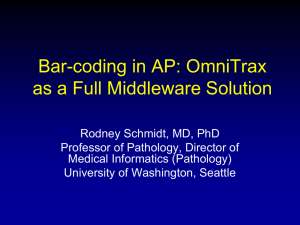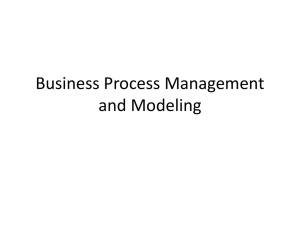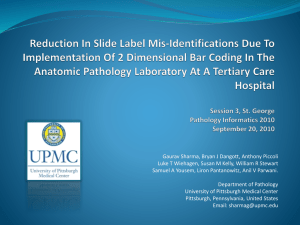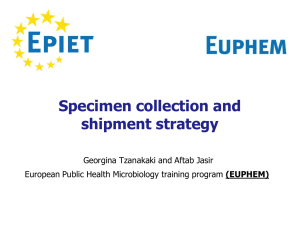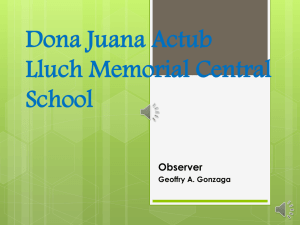Presentation
advertisement
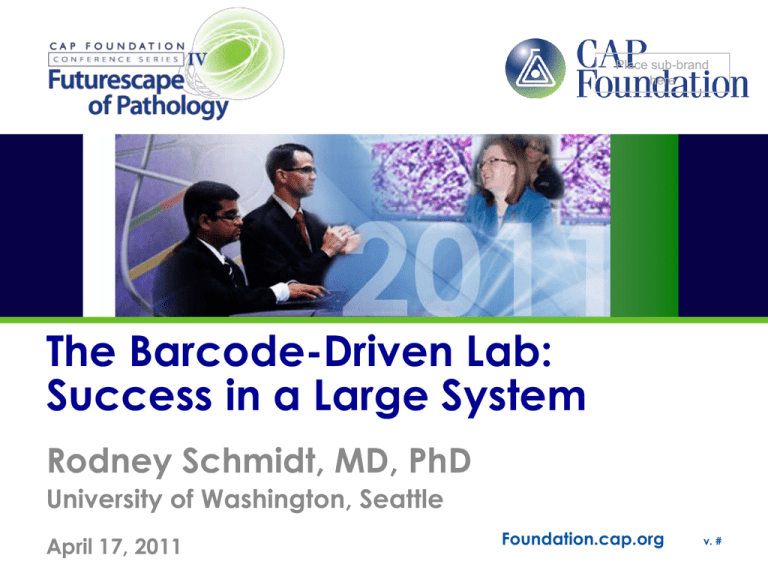
Place sub-brand here The Barcode-Driven Lab: Success in a Large System Rodney Schmidt, MD, PhD University of Washington, Seattle April 17, 2011 Foundation.cap.org v. # Topics • Why create the barcode-driven lab? – Why in a large, complex lab? – Overview of functionality • Not the detailed “how”; workflow – Achieved benefits • Error reduction • FTE savings • Important factors in success – UCLA, Sierra Pathology, NWP, NYU, OHSU • What’s down the road? Disclosure • Bar-coding software developed at UW (OmniTrax and OmniImage) has been licensed by UW to Pathway Pathology Consultants for PowerPath end-users. • Dr. Schmidt and his team have a revenuesharing agreement with UW. • Dr. Schmidt has a consulting agreement with Thermo-Fisher for educational talks. Why barcode? • Expensive – $23k/gross station – $10k/cutting station – Software • Workspaces change – Wiring, networking • Time investment • Processes change – Material handling – QA • Jobs change – Workflow – Change management • Pathologists affected! – Software fast – Workspaces slow – Financing slow Who needs the hassle?! Large Systems – Special Factors • • • • • • Multiple locations Trainees – Residents and Fellows Personnel turnover Outside materials (e.g. consults) Ancillary testing Higher fraction of complex cases Issues: Training, complexity, communication Need: Robust systems to help people do things right Bringing Bar-coding to AP • Track slides (2005) – Eliminate the “lost slide” problem – Ease conference prep • Specimen labels (2006) – Tissue discards and tracking – Drive gross photography • Block creation and labeling (2008) – Automated JIT production of barcoded blocks – Gross room QA process and tracking • Slide creation and labeling (2008) – Automated JIT creation of barcoded slides – Facilitate workflow and QA • Eliminate all manual labeling (and errors) • Facilitate workflow – JIT information display Material identification (2005) • Handwritten specimen labels • Manual, offline cassette labeling • Hand-written slide labels Primary labeling errors (2004) 1000 900 800 700 600 500 400 300 200 100 0 ? Blocks Recorded Slides Actual Accession number is re-entered into a standalone cassette imprinter Targets – Gross Room • Foolproof labeling – No human labeling/data entry • Reduced dependence on support staff – Off-hours availability – Redirection of support personnel • Reduced waste of cassettes • Grossing step at least as fast as current • (Record timestamps) The unsupervised Resident! Targets - Accession Receive specimen and enter data into the LIS Generate a bar coded label for the specimen and laboratory request form. Minimum extra keystrokes (one) Classic Grossing Workflow Accession specimens Label specimens Label cassettes Group with specimens Move to staging area * * * Move to gross bench Lay out cassettes Fill cassettes * * Request more cassettes Store excess with specs Handling steps Rack filled cassettes Reconcile with LIS * Transport for processing * Possible errors * QA steps Just-in-Time Printing Accession specimens Bar-code specimens Fewer handling steps Fewer (1) error opportunities Scan/print cassettes Lay out cassettes Fill cassettes * * Fewer QA processes Rescan cassettes Courtesy General Data Rack filled cassettes * Transport for processing * Benefits • Efficiency – – – – No manual pre-printing and sorting of cassettes Quick just-in-time additional cassettes Default cassettes from PowerPath specimen panels Blocks automatically ordered in PowerPath • Quality – No manual labeling (no errors) – Scanning specimen barcode assures correct specimen – Enter cutting instructions, # pieces – Records which blocks are sent for processing Q&E Benefits “Classic” “Just-in-Time” Handling steps 11 5 Error opportunities 9 1 Manual QA steps 7 4 Primary labeling errors 988/yr (est.); (1.2%) 2 in 3 mo (initial); 0 in next 7 mo; (0.003%) Cassette wastage ~25/d (~7%) ~0 Grossing efficiency -- At least as fast Support staff -- 0.75+ FTE saved Histology – Embedding • Target – View critical information about block and specimen – Efficient workflow • Block scan: – Embedding instructions – Number of pieces of tissue – Specimen info – (Record timestamps) Histology – Cutting • Targets – Present critical information (block, specimen) – Eliminate manual slide labeling – Block/slide verification – Multiple workflows – No clutter – Efficient • Touch-screens; no keyboards • Block scan: – JIT slide printing/labeling – Info display • Slide scan: – Block/slide match Cutting - Benefits • Elimination of hand labeling • Much faster than manual labeling for blocks with many slides • Fewer block/slide mismatches • Overall throughput increased ~10% Slide Life Cycle Histology Pathology Offices Sendouts Faculty signout File Histology work order completes with scanning Pull for conference Ship Resident review Deliver Slides – Benefits • Less staff time looking for slides • Faster to find last location than make a phone call • Fewer arguments over whether slides were delivered • Fewer recuts? • Improved job satisfaction – ** Saved me 30 min the first day! ** • Overall savings > 2.0 FTE! Slides Benefits FTE Savings Histology +0.5 FTE Reduced time hunting for mis-delivered slides +0.5 FTE Auto completion of outstanding orders when slide is scanned Office staff +.5-1 FTE +.25 FTE Reduced time for conference preparation Increased efficiency regarding send outs Barcodes Enable… • Imaging – – – – Gross photos Photomicrographs Documents EM/IF • Specimen management – Discards – Locations • Winscribe automation • HPV workflow – Reflex testing – Digene/Luminex Specimen Discard Workflow – Device scans specimen barcode – Handheld device queries AP-LIS • If case signout occurred <2wks prior • If case signout occurred >2wks prior • If note on Req Data tab, caution light and note display Barcoding Benefits • Direct personnel (FTE) – 2.0 – 0.75 – 0.1 – 0.1 – TBD Slide delivery and tracking Cassette printing Specimen discards Document scanning Fluorescence image import ~$150,000/yr assuming $50,000/FTE Barcoding Benefits • Indirect personnel (FTE) – 0.5 – TBD – TBD Scanned consult document availability1 Scanned Req forms Slide location info (e.g. Pathologists) • Reduced loss of materials – Slide/Block tracking – Specimen discards 1Schmidt, RA, et al. Am J Clin Pathol 126:678-83, 2006 Barcoding Benefits Error Reduction – Elimination of all manual labeling steps! – Reduced labeling errors • Specimens • Blocks – ~988/yr to near 0 – “How did you manage to do that?!” • • • • Slides Gross photos Scanned documents Photomicrographs Reasons for Success • Optimized workflow – Lean analysis – Close ties to users – Multiple workflows; exception trapping • LIS interoperability – Initially with PowerPath; now general • Just-in-time production of materials • Selection of appropriate equipment Where Next? • Specimen transport – Within multiple sites in a large lab – Upstream all the way from the patient • Result transport – All the way back to the patient • Likely to need multiple systems Need an industry barcode standard Where Next? • Tissue banking (becoming routine) – Unique identifiers (encrypted for research) – Repository management – Maintain provenance – Pre-analytic variables • Tissue micro-arrays – Each sample linked back to patient Where Next? Patient- and time-based disease data structures Patient Treatment 1 Diagnosis •Links between serial samples of same disease •Relation to clinical treatment •Correlated blood samples (Time) Treatment 2 Persistent Recurrence All types of data •IHC •Cytogenetic •Molecular What does sample tracking mean for molecular testing? Why barcode? Expensive Workspaces change Process changes … true, but reasonable ROI … it might be time … new processes are better Jobs change … but more valuable activity Pathologists affected Time investment … in good ways … pays off! Better lab efficiency Error/liability reduction Inventory control Resident autonomy Gateway to more functions Conclusion • Barcoding is becoming an expectation – Patient safety / error reduction • It’s to your financial advantage For success, you must be sophisticated enough to know the difference between just putting a barcode on something and having a barcode-driven lab. Acknowledgements • • • • • Phil Nguyen Kevin Fleming Rosy Changchien Chris Magnusson Victor Tobias • General Data • Thermo-Fisher • Accu-Place • • • • • • Dr. Erin Grimm Dan Luff Steve Rath Pam Selz Kim Simmons All the Techs and Office Folks! Achieved Benefits • Marked reduction in labeling errors • Improved inventory control (i.e. knowledge of where things are) • Direct savings of ~ 3 FTE • Indirect savings of >> 0.5 FTE • Improved image collection and management (paperwork, gross, micro, EMs, IF, etc) • Increased job satisfaction
